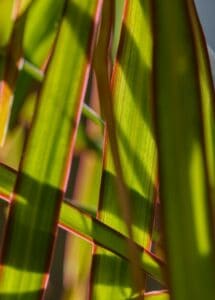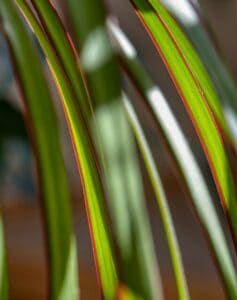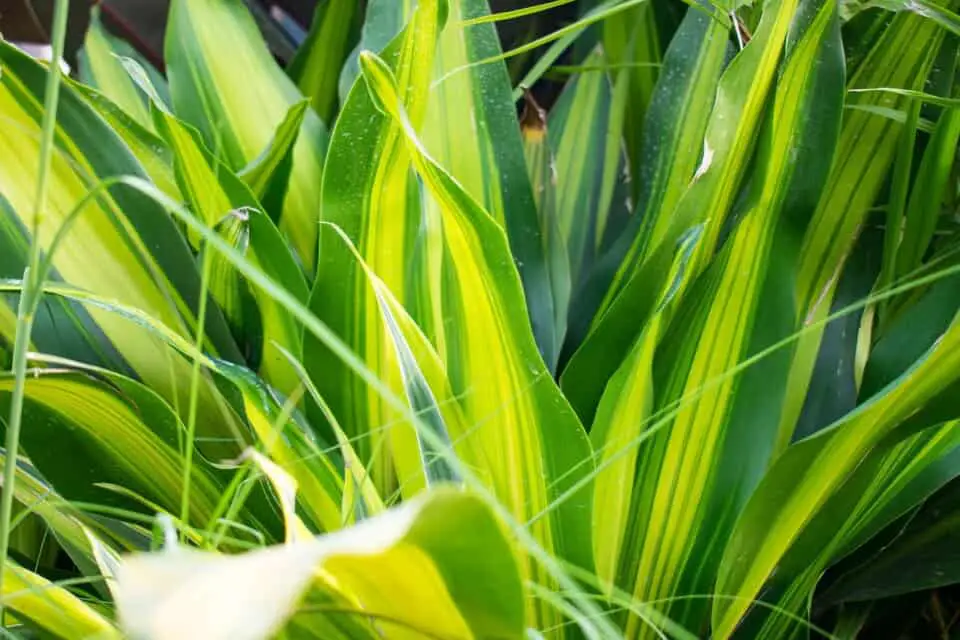Some links in the post are affiliate links and I get a commission from purchases made through some links found in the post.
Dracaena plant is an ornamental plant grown both indoors and outdoors. It typically inhabits the subtropical climate and has strap-like leaves that emerge from a thick stalk.
A common problem you can face with Dracaena is that its leaves could turn yellow. If you’re facing this problem and want to know how to fix it then your answer is right here.
Dracaena grows best in moderate humidity, moist soil with bright indirect sunlight. It also requires monthly fertilizing.
The leaves of a dracaena can be turning yellow for many reasons, the most common reason is overwatering, it likes to be kept damp not soggy.
Other reasons include too many salts in the soil, dry heat exposure, direct sunlight, and poor water quality.
If you want to learn more detail on how yellowing develops and how to fix them then keep on reading.
Why is my Dracaena Turning Yellow?
Dracaena is an excellent indoor plant that is relatively easy to care for. It does well in bright indirect sunlight and can tolerate low light with slower growth.
The plant has strap-like bright to light green variegated leaves which grow spirally upwards from a central wooden trunk.
The dracaena leaves can be turning yellow due to many reasons. Some reasons along with ways to correct the yellowing are as follows:
1) Overwatering
 Overwatering is one of the main reasons why your dracaena leaves are turning yellow. Excess water makes the leaves turn pale to yellow. The leaves become limp, lose rigidity, and start to droop and sag.
Overwatering is one of the main reasons why your dracaena leaves are turning yellow. Excess water makes the leaves turn pale to yellow. The leaves become limp, lose rigidity, and start to droop and sag.
Yellow-brown spots may also form on the leaves. The uppermost leaves are less affected than the bottom ones. Remember that over-watering not only yellows the leaves but also makes your plant prone to root rot and fungus.
On the other hand, underwatering doesn’t cause yellowing but does cause the leaves to turn brown and crisp.
How to Fix Overwatering:
In order to fix yellowing due to overwatering, water only when the plant needs it. If the soil is too moist or soggy, it gives off a foul odor.
Feel the top 2 inches of the soil to check for moisture, only water when the ground feels dry to touch. Organic matter turns black in the presence of extra water.
Fix your watering schedule and remember to check the clogged pores. Inspect the roots by taking the plant out of its pot.
Take them out if the roots have rotted and appear mushy and translucent. Yellow leaves may recover this way.
You may also like: 7 reasons why your dracaena is drooping & how to fix them
2) Natural Yellowing
The leaves naturally turn yellow and fall off with age. Fresh new leaves emerging from the top are bright green, while those that die off gradually fade from green to pale to yellow.
Aging is inevitable, and your plant is bound to have old yellow leaves.
3) Dry Air Exposure
If exposed to dry and hot air for long times, the edges of the leaves become brown to yellow.
The crustiness starts at the edges of the leaves and gradually takes over the whole leaf. Yellowing due to heat exposure can not be reversed. The plant does not like too low humidity levels.
How to Fix Dry Air Exposure
You can prevent yellowing due to heat exposure by not placing the plant in hot and windy corridors. Keep the plant away from heat blowers and radiators.
Place the plant on a pebble tray containing water. Do not let the bottom of the pot dip into the water.
As water evaporates from the pebble tray, humidity increases around the plant. Misting the plant periodically and using a humidifier can increase the plant’s survival.
Also, remember that exposing the plant to cold drafts is also a risk for the plant. So don’t place the plant in front of an air conditioner or the cold outside weather.
If the humidity is the main issue, using a pebble tray underneath the plant will fix the yellowing in a few days.
You may also like: How big can a dracaena get
4) Sudden Temperature Changes
If temperatures suddenly change, your Dracaena may not be able to cope, and its leaves may react by turning yellow.
The Dracaena does best at steady temperatures of 70 to 80 degrees Fahrenheit. Temperature changes come as a blow to most plants and hamper their ability to strive.
How to Fix Sudden Temperature Changes
Maintain steady temperatures for your dracaena plant to avoid the yellowing of its leaves. Do not place the plan near open windows if the outside temperature fluctuates significantly.
When shifting the plant from one room to another or inside to outside, make sure the temperature is ideal at the new location and gradually move it, giving the plant time to adjust.
5) Poor Water Quality
 Poor water quality can also lead to the yellowing of the leaves of Dracaena. Poor water quality means water containing excessive amounts of minerals.
Poor water quality can also lead to the yellowing of the leaves of Dracaena. Poor water quality means water containing excessive amounts of minerals.
The abundance of minerals like fluoride can especially cause the leaves of the dracaena plant to turn yellow. Excess minerals can also deposit on the leaves and make them weak.
How to Fix Poor Water Quality:
Don’t use tap water to water your Dracaena. Instead, make use of either distilled water or use rainwater. Look for mineral deposits on the leaves to confirm the problem.
You may also like: Dracaena vs yucca
6) Salt Build up
Fertilizer salts, including superphosphate, can also lead to the yellowing of dracaena leaves.
Potting soil containing perlite used for this plant can also lead to yellowing or browning since this type of soil also has a lot of superphosphates.
How to Fix Salt Build Up:
Use a liquid fertilizer instead of solid fertilizers for your plant. Take the appropriate gap between fertilizing your plant.
If you feel that the soil contains too much fertilizer, consider running water excessively through the soil and let the water drain out through the bottom of the pot.
Observe the plant for a few days after running the water through the soil. If the condition does not improve and there is still fertilizer in the soil, consider repotting the plant into soil containing fewer minerals.
7) Pest Infestation
Poor watering schedules and poor growing conditions weaken the dracaena plant and make the plant susceptible to infestation by spider mites, mealybugs, and scales.
The insects suck the sap and weaken the plant. This leads to the leaves of your dracaena plant turning yellow. The pests can also nick the leaves.
How to Fix a Pest Infestation
Remove the pests of the plant by giving the plant a rather forceful water shower. This would shake off the pests. Remove the excessively damaged leaves and stems.
Use insecticide soap made of neem oil or use a permethrin solution to keep away the pests. Keep your infested plants separate from your healthy plants.
Preventing grouping and place them in the open air with nice ventilation. This would prevent re-infestation.
You may also like: 5 great benefits of a dracaena for your home
8) Direct Sunlight
Bright direct sunlight falling on the leaves of Dracaena can lead to scorching of the leaves. The leaves then turn yellow and brown. Excess light can easily damage sunlight-sensitive plants like Dracaena.
How to Fix Direct Sunlight Issues:
Place the plant away from sunlight, not in the open and not near a brightly lit window. Keep the plant under medium indirect sunlight to prevent complete drying of the plant.
9) Insufficient light
Insufficient light can lead to pale and yellow leaves. Low light conditions make it difficult for the plant to synthesize its food and produce energy.
How to Fix Insufficient Light Issues:
Do not scorch the plant but do provide enough sunlight to sustain the chlorophyll production of the plant.
Although the plant sustains in moderate to low light, completely depriving the plant would inevitably lead to the yellowing of the plant’s leaves.
If you need more information, check out our article on dracaena marginata light requirements.
10) Fungus and Bacterial Infections
Fungi and bacteria can attack Dracaena in humid and moist conditions. The fungi deprive the plant of its nutrients and make the leaves turn pale to yellow with brown spotting.
Bacteria can also harm the plant and cause it to turn brown or yellow.
How to Fix Fungus and Bacterial Infections
Keep the infected plant away from other healthy plants. Use fungicide sprays on the plant. This may cure the disease. Prune and remove the damaged portion of the plant not cured by this method.
Take good care of cleanliness and keep infected plants away from your healthy dracaena plant to prevent it from getting infected in the future.
Final Thoughts
 Dracaena is an ornamental plant placed indoors for its beautiful foliage and contrasting colors. The plant has strap-like green leaves.
Dracaena is an ornamental plant placed indoors for its beautiful foliage and contrasting colors. The plant has strap-like green leaves.
Fixing your watering schedule, using tap water or distilled water, placing the plant in medium indirect sunlight, and putting the plant in adequate humidity can benefit your plant and regain its color.
Don’t worry if the old leaves turn yellow. It’s their natural aging process. Just maintain good growing conditions, and you wouldn’t see any yellowing of the leaves.
Before you go, here are some more related articles I encourage you to read below to help solve more of your gardening issues:
What is the Best Soil for a Dracaena Marginata
How to Care for a Dracaena Outdoors
How to Save a Dying Dracaena Marginata Plant
About the Author:
Saad Ansar
Saad is an avid gardener himself and is a great lover of plants, animals, photography, & people. Currently, he is focused on photographing indoor plants & captioning beautiful outdoor sceneries. He writes and rewrites in-depth articles on nature and science.


